Rare Books: A Glossary
Aquatint — Buckram

Aquatint: An intaglio illustration practice developed in 1768. Aquatint is a variation on etching, but resin is applied to the plate rather than wax. The resin develops a cracked surface, which is then etched and burnished. The effect is reminiscent of mezzotint but is achieved through etching rather than engraving.
Image: Labus, Giovanni, 1775-1853. Ara antica scoperta in Hainburgo dal signor consigliere Stefano, nobile de Mainoni. Milan: G.G. Destefanis, 1820. CN543 .H3 L3
Aquatint: An intaglio illustration practice developed in 1768. Aquatint is a variation on etching, but resin is applied to the plate rather than wax. The resin develops a cracked surface, which is then etched and burnished. The effect is reminiscent of mezzotint but is achieved through etching rather than engraving.
Archive: A collection of records that all derive from a common source. The term is also used to describe institutions that collect and preserve archives, much the same why the word “library” often refers to a building as well as a collection, but anyone can maintain an archive. Most archives are based in an author, family, or institution’s papers, i.e., the documents that were created, received, used, and kept by that author or institution. Archives tend not to be published materials, though they may be publicly accessible even before they enter an archival institution (as in the case of many government and institutional documents).
Bibliography: The study and description of books historically and as physical objects, literally “the writing about books.” The term can also mean a list of books and articles.
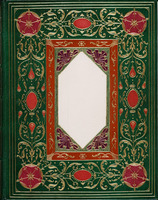
Binding: A term used to describe both the protective covers of a codex book and the act of adding those covers. There are countless styles of binding and they can consist of almost anything, but paper, various leathers, parchment, linen, and buckram are the most common materials. Since the 19th century, publishers have started supplying ready-made bindings for all their books; before then, books’ owners needed to have them bound by a specialist. Fine bindings are an art form.
Image: Shakespeare, William, 1564-1616. Sonnets. Cambridge, MA: Geo. D. Sproul, 1901. PR2848.A2 L4 1901
Binding: A term used to describe both the protective covers of a codex book and the act of adding those covers. There are countless styles of binding and they can consist of almost anything, but paper, various leathers, parchment, linen, and buckram are the most common materials. Since the 19th century, publishers have started supplying ready-made bindings for all their books; before then, books’ owners needed to have them bound by a specialist. Fine bindings are an art form.
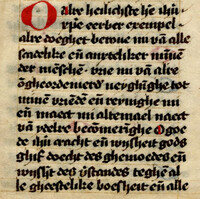
Blackletter: A style of letter, often also called “Gothic.” Blackletter handwriting was particularly popular in northern Europe and is distinguished by its heavy use of thick vertical pen strokes (called minims). The first European printing was done in blackletter, though today its use is largely limited to certificates and heavy metal posters.
Image:Devotional text (Fragmenta Manuscripta 128). Low Countries, 1300-1399. Z109 .F73. Available digitally at the Digital Scriptorium.
Blackletter: A style of letter, often also called “Gothic.” Blackletter handwriting was particularly popular in northern Europe and is distinguished by its heavy use of thick vertical pen strokes (called minims). The first European printing was done in blackletter, though today its use is largely limited to certificates and heavy metal posters.
Blockbook: A book printed entirely using woodblocks. Blockbooks predate printing with moveable type, both in Europe and Asia.
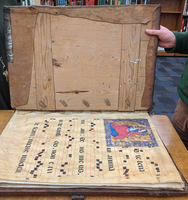
Boards: The core of the protective covers on a codex book, i.e., the part of the covers that makes a book “hardcover.” Initially, book boards were made of wood (especially beech and oak), but they would eventually transition to pasteboard, pulpboard, or other forms of cardboard.
Image: Choirbook, northern Spain, ca. 1500.
Boards: The core of the protective covers on a codex book, i.e., the part of the covers that makes a book “hardcover.” Initially, book boards were made of wood (especially beech and oak), but they would eventually transition to pasteboard, pulpboard, and other forms of cardboard.
Book: A collection of text that has been published or written in a portable format. Books come in numerous forms, ranging from scrolls to the codex. Most of the time, when people say “book,” they actually mean a “codex,” but books come in many other forms. It is worth emphasizing this point: while the codex may be the dominant book form at present, scrolls and other book forms are also books.
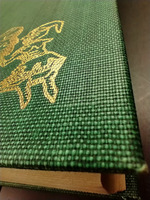
Book cloth: A catch-all term for textile materials, usually cotton or linen, used to bind books. Since the 1820s, cloth bindings have been the standard approach for trade bindings issued by publishers.
Image: Yeats, W. B. (William Butler), 1865-1939. Irish folk tales. Avon, CT: Printed for the members of the Limited Editions Club, 1973. PZ8.Y34 Ir
Book cloth: A catch-all term for textile materials, usually cotton or linen, used to bind books. Since the 1820s, cloth bindings have been the standard approach for trade bindings issued by publishers.
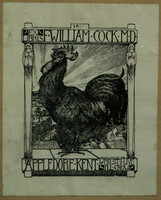
Bookplate: A tag or sticker placed in a book to indicate ownership, usually affixed on an endleaf or paste-down. Bookplates often featured family crests, mottos, and other phrases, typically in Latin. A nice bookplate from a famous collector adds value to the book. The phrase “Ex libris,” which was used on many bookplates, has become another name for them.
Image: Law, John, Archdeacon of Rochester. A sermon preached at the visitation of the Right Reverend the Lord Bishop of London, in the Church of Thaxted, in Essex, on Wednesday, May 28, 1778. Rochester: Printed by T. Fisher, and sold by Payne and Son ... and John Pridden ...,1778. BT1105 .L38 1778
Bookplate: A tag or sticker placed in a book to indicate ownership, usually affixed on an endleaf or paste-down. Bookplates often featured family crests, mottos, and other phrases, typically in Latin. A nice bookplate from a famous collector adds value to the book. The phrase “Ex libris,” which was used on many bookplates, has become another name for them.

Broadside: A sheet of paper that has been printed on one or both sides. Properly speaking, a broadside is complete without other sheets of paper and can be read without any further changes (i.e., folding or combining it with other items). Broadsides were often sold with music, art, or news printed on them; the term is also sometimes used to refer to a newspaper format.
Image: The rat-catchers daughter. New York: Andrews, 1800s. PS477 .C65 1850z
Broadside: A sheet of paper that has been printed on one or both sides. Properly speaking, a broadside is complete without other sheets of paper and can be read without any further changes (i.e., folding or combining it with other items). Broadsides were often sold with music, art, or news printed on them; the term is also sometimes used to refer to a newspaper format.
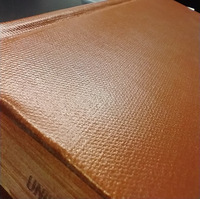
Buckram: A sturdy book cloth, commonly made of cotton and occasionally of linen, that has been strengthened by saturating it with a sizing agent. In terms of durability, it is equivalent to leather but doesn’t require slaughtering livestock, which perhaps explains its popularity. Most library books found in open stacks are bound in buckram, typically black or brown.
Image: Imperatorskai︠a︡ akademīi︠a︡ naukʺ (Russia). Nova acta Academiae scientiarum imperialis petropolitanae. Saint Petersburg: Typis Academiae Scientiarum,1783-1784. AS262 .S313 (1783-1784) v.1-2
Buckram: A sturdy book cloth, commonly made of cotton and occasionally of linen, that has been strengthened by saturating it with a sizing agent. In terms of durability, it is equivalent to leather but doesn’t require slaughtering livestock, which perhaps explains its popularity. Most library books found in open stacks are bound in buckram, typically black or brown.